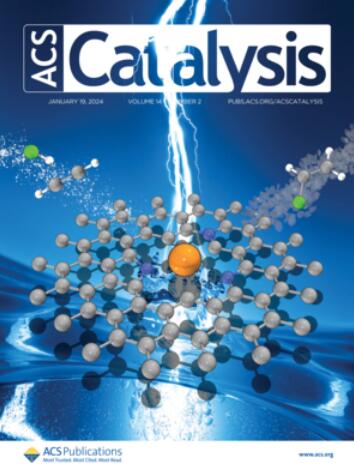Atomically Dispersed Fe–N–C-Catalyzed Intermolecular Reductive Coupling toward the Synthesis of Benzimidazoles
IF 13.1
1区 化学
Q1 CHEMISTRY, PHYSICAL
引用次数: 0
Abstract
Benzimidazoles are privileged structural motifs in pharmaceuticals due to their diverse biological activities. Herein, we report an atomically dispersed iron catalyst (Fe-NC-800) for the reductive coupling of 2-nitroacetanilides with various aldehydes to synthesize structurally diverse benzimidazoles. The catalyst is synthesized through a template-sacrificial strategy and contains atomically dispersed Fe–N4 active sites embedded in a nitrogen-doped carbon matrix. This transformation proceeds with high efficiency (conversion: 100%; yield: up to 89%), broad substrate scope (>50 samples), and functional group tolerance, delivering valuable benzimidazoles with good yields. Notably, this method achieves benzimidazole synthesis via an intermolecular coupling rather than an intramolecular cyclization process, distinguishing it from conventional strategies. Mechanistic studies reveal a stepwise hydrogenation pathway involving imine and amine intermediates, with Fe–N sites playing a crucial catalytic role. Additionally, the catalyst demonstrates great recyclability and stability, making it a promising platform for modern organic synthesis.

原子分散fe - n - c催化的分子间还原偶联合成苯并咪唑
苯并咪唑由于其多样的生物活性,在药物中具有特殊的结构基序。本文报道了一种原子分散的铁催化剂(Fe-NC-800),用于2-硝基乙酰苯胺与多种醛的还原偶联,合成结构多样的苯并咪唑。该催化剂通过模板牺牲策略合成,包含原子分散的Fe-N4活性位点嵌入氮掺杂碳基质中。这种转化以高效率进行(转化率:100%;收率:高达89%),广泛的底物范围(>;50个样品),和功能基耐受性,提供有价值的苯并咪唑和良好的收率。值得注意的是,该方法通过分子间偶联而不是分子内环化过程实现了苯并咪唑的合成,这与传统的方法不同。机理研究揭示了一个涉及亚胺和胺中间体的逐步加氢途径,其中Fe-N位点起着至关重要的催化作用。此外,该催化剂表现出很强的可回收性和稳定性,使其成为现代有机合成的一个有前途的平台。
本文章由计算机程序翻译,如有差异,请以英文原文为准。
求助全文
约1分钟内获得全文
求助全文
来源期刊

ACS Catalysis
CHEMISTRY, PHYSICAL-
CiteScore
20.80
自引率
6.20%
发文量
1253
审稿时长
1.5 months
期刊介绍:
ACS Catalysis is an esteemed journal that publishes original research in the fields of heterogeneous catalysis, molecular catalysis, and biocatalysis. It offers broad coverage across diverse areas such as life sciences, organometallics and synthesis, photochemistry and electrochemistry, drug discovery and synthesis, materials science, environmental protection, polymer discovery and synthesis, and energy and fuels.
The scope of the journal is to showcase innovative work in various aspects of catalysis. This includes new reactions and novel synthetic approaches utilizing known catalysts, the discovery or modification of new catalysts, elucidation of catalytic mechanisms through cutting-edge investigations, practical enhancements of existing processes, as well as conceptual advances in the field. Contributions to ACS Catalysis can encompass both experimental and theoretical research focused on catalytic molecules, macromolecules, and materials that exhibit catalytic turnover.
 求助内容:
求助内容: 应助结果提醒方式:
应助结果提醒方式:


